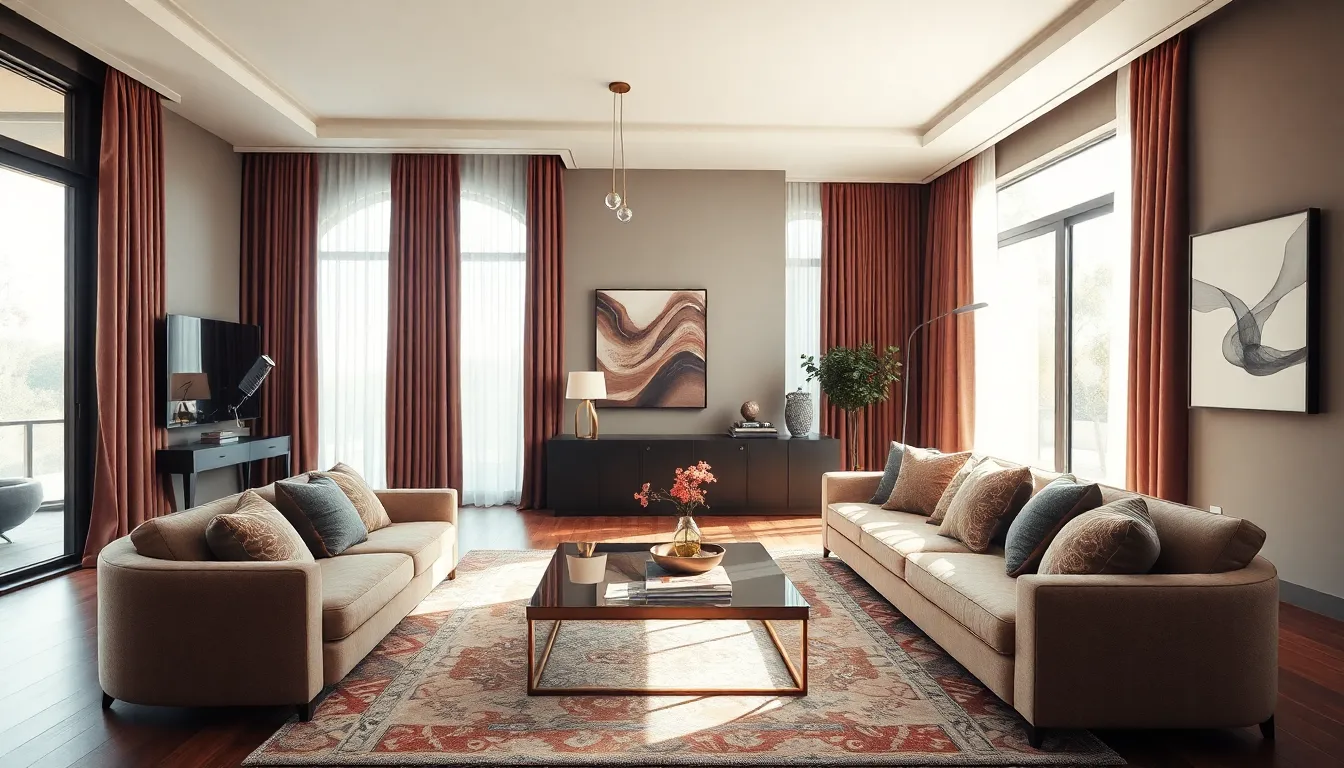When it comes to interiors, the right design can transform any space from drab to fab faster than you can say “throw pillow.” Whether it’s a cozy nook or a sprawling living room, the way a space is styled can make all the difference. After all, who wouldn’t want a home that feels like a Pinterest board come to life?
Table of Contents
ToggleUnderstanding Interiors
Interiors play a vital role in defining a space’s atmosphere and functionality. Thoughtful design choices enhance comfort, reflect personal styles, and create visually appealing environments.
Definition and Importance
Interior design involves the art and science of enhancing indoor spaces, focusing on aesthetics and functionality. A well-designed interior significantly influences mood and productivity. Research indicates that a thoughtfully arranged environment can increase happiness and reduce stress. Organizations and individuals recognize that practical design improves not only the attractiveness of a space but also its usability. Effective interiors cater to the needs of inhabitants while ensuring efficient use of available space.
Types of Interiors
Various types of interiors serve specific purposes and styles. Residential interiors prioritize comfort and personal expression. Commercial interiors focus on branding and functionality, catering to both employees and clients. Hospitality interiors enhance guest experiences in hotels and restaurants. Educational interiors support learning environments in schools and universities. Each type requires unique design elements and considerations to optimize space effectively. Understanding these categories aids in choosing the right design approach for different environments.
Popular Interior Styles

Various interior styles cater to different tastes and preferences. These styles significantly influence the overall vibe of a space.
Modern Interiors
Modern interiors emphasize clean lines and simplicity. Key elements include neutral colors, open spaces, and a focus on function. Furniture often features sleek materials like metal, glass, and wood. Accessories remain minimal, with art pieces enhancing visual interest without overwhelming the design. Furniture arrangements prioritize flow and accessibility, creating comfortable living spaces. Large windows allow natural light, contributing to an airy atmosphere. This style reflects contemporary lifestyles while promoting relaxation and practicality.
Traditional Interiors
Traditional interiors exude warmth and elegance through classic design features. Rich colors, ornate woodwork, and intricate patterns characterize this style. Furniture typically includes details like carvings and rich fabrics, adding a luxurious touch to the space. Accessories encompass fine art, decorative objects, and elegant draperies, enhancing the ambience. Rooms often showcase symmetry in layouts, fostering a balanced feel. This style celebrates history while ensuring comfort and timeless beauty, making it appealing for many homeowners.
Minimalist Interiors
Minimalist interiors focus on function and simplicity. With a “less is more” approach, this style emphasizes essential furnishings and neutral palettes. Natural materials such as wood and stone often appear in both furniture and decor, promoting tranquility. Spaces feature uncluttered surfaces, creating an open and spacious feel. Thoughtful design decisions prioritize functionality without sacrificing aesthetics. Lighting plays a crucial role, with large windows or unobtrusive fixtures enhancing the overall environment. This style caters to those seeking peace and order in their surroundings.
Key Elements of Interior Design
Key elements shape the essence of interior design, creating functionality and style in spaces. Each facet contributes significantly to the overall look and feel of a home or business.
Color Schemes
Color schemes establish the mood of a space. Select complementary colors to create harmony. Consider using a neutral base, then layer with accent colors for depth. Color psychology plays a vital role; for example, blues promote calmness, while yellows infuse energy. An effective palette enhances the room’s purpose, whether that’s relaxation or productivity.
Furniture Selection
Furniture selection defines both aesthetics and comfort. Prioritize functionality by choosing pieces that meet user needs. For small spaces, multifaceted furniture like storage ottomans or extendable tables maximizes utility. Different styles provide contrasting effects; modern furniture offers sleek sophistication while traditional pieces evoke warmth. Ensure pieces are proportionate to the space, maintaining flow and accessibility.
Lighting Choices
Lighting choices significantly impact both ambiance and functionality. Mix various light sources to achieve balance; combine ambient, task, and accent lighting for optimal results. Use dimmers for flexibility in controlling brightness. Natural light enhances well-being, so consider window treatments that maximize sunlight. Decorative fixtures not only illuminate but also serve as impactful design statements.
Trends in Interior Design
Interior design trends evolve to reflect changing values and technological advancements, focusing on aesthetic appeal and functionality.
Sustainable Interiors
Sustainable interiors prioritize eco-friendly materials and energy efficiency. Designers increasingly select renewable resources, such as bamboo and reclaimed wood, to reduce environmental impact. Energy-efficient appliances and LED lighting contribute to lower utility costs and a smaller carbon footprint. Biophilic design elements, like indoor plants and natural light, enhance well-being, improving air quality and reducing stress. These choices create harmonious spaces that blend style with sustainability, appealing to environmentally conscious homeowners.
Technological Advances
Technological advances revolutionize interior design, integrating smart home features for enhanced convenience. Smart thermostats, lighting systems, and security cameras provide remote access and control, increasing energy efficiency and safety. Virtual reality tools enable designers to create immersive experiences, allowing clients to visualize spaces before making decisions. Augmented reality apps empower homeowners by providing design ideas tailored to their styles. These innovations streamline processes, making interior design more interactive and accessible, ultimately elevating the overall experience.
The world of interior design is a dynamic blend of art and science that shapes the way people experience their environments. By embracing various styles and elements, individuals can create spaces that not only reflect their personal tastes but also enhance their overall well-being.
As trends continue to evolve, the focus on sustainability and technology becomes increasingly important. Homeowners can look forward to innovative solutions that make their spaces more functional and aesthetically pleasing.
With thoughtful design, anyone can transform their home into a sanctuary that promotes comfort, happiness, and productivity.


